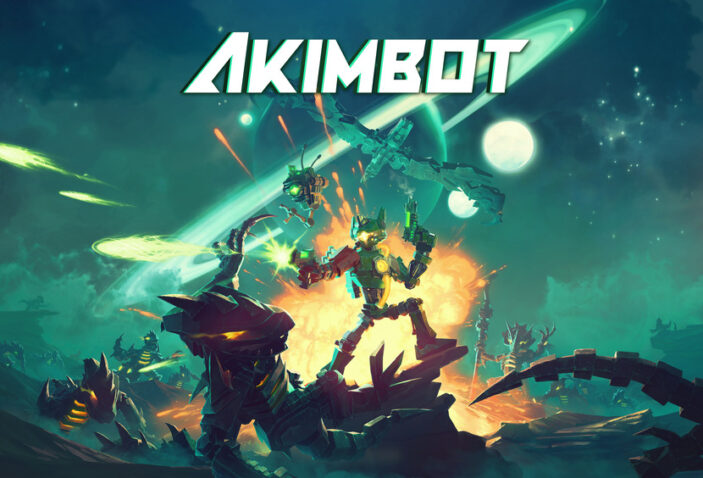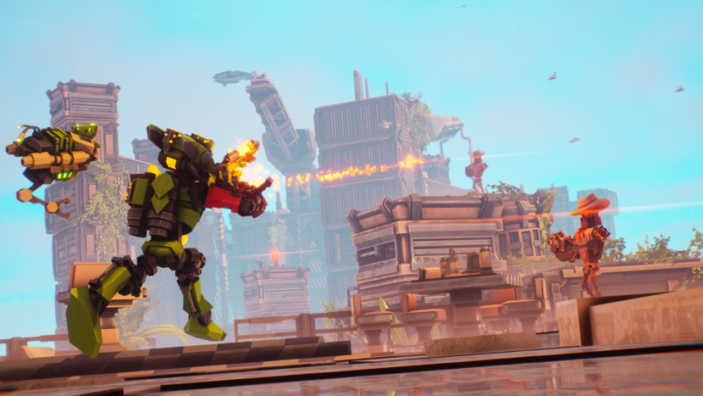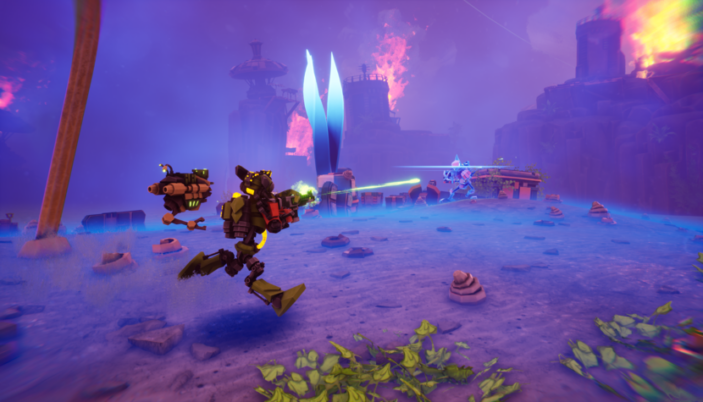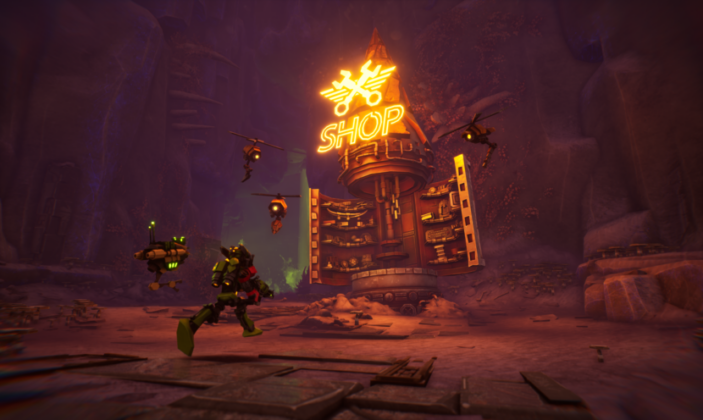
In a media age where remakes, sequels, and reboots dominate, the weaponising of nostalgia has brought both glee and despair to gamers everywhere. When handled with care, recycling the old can be a fun exercise but there is something to be said for finding something new in the familiar.
Akimbot, the latest release by Evil Raptor, seeks to do just that. Serving as a vibrant throwback and homage to the PS2 era of action-adventure platformers, Akimbot is drenched in the influence of classics like Ratchet and Clank and Jak and Daxter. While comparison is the thief of joy, even under the heavy shadow of comparison to the legends it emulates, Akimbot still manages to shine in moments—just not quite brightly enough to fully escape that shadow.
First Protocols First
The narrative of the game itself is totally serviceable and comfortably ridiculous. Set in a universe devoid of humans, Akimbot follows robotic mercenary Exe and his wisecracking drone companion, Shipset. Their journey begins with a prison break and spirals into an intergalactic war involving time travel, dinosaur robots, and a rogue scientist named Evilware. Recruited to stop Evilware from using a time-warping artifact to control the universe, Exe and Shipset’s adventure is a zany adventure that fully embraces its sci-fi setting and throwback roots.
The game is at its best when you laugh along with the absurdity, and while it’s hard to take the ever-growing stakes too seriously, that works to the game’s advantage. You could poke holes in the confetti cannon of a plot, but thinking too deeply about a raccoon thief during Sly Cooper would probably ruin that too. It’s truly a fun premise, and the game has enough self-awareness to be a video game and just have fun with it.

While the story serves its purpose, the game does falter by not diving deeper into its world or characters. There is a big robotic world out there primed for exploration, but it feels retrained and unreachable. The ‘Lost Data’ collectibles tell a small story about the people living on the planet, but I want just a bit more. Whether a feature or a bug, I can’t quite shake the surface-level world-building. The story, however, certainly turns up the fun factor in exchange and maintains enough charm to carry you through. I just wish it went a little deeper.
Scrapping and Shooting
Where Akimbot shines brightest is in its fusion of third-person shooting mechanics and platforming. The basics are there—shoot, jump, dash—across vast, open landscapes filled with enemies, deadly environments and the occasional puzzle or mini-game. At its best, the game channels Ratchet and Clank and Jak and Dakster, especially when you’re mowing down enemies with a rocket launcher, assault rifle, sniper and even a tank. The shooting feels snappy and the platforming is serviceable, though never ground-breaking or truly memorable.
The enemy variation also makes for plenty of satisfying engagements, whether that’s a swooping robot bat, an electrified fence or an intergalactic ship needing to be shot out of space. The difficulty can chop and change, but understanding your arsenal will get you out of most spots. Plus, the game is forgiving almost to a fault at the lower difficulties.

The game does feel like it understands its own pace well, dropping in a new weapon, mechanic or even a challenging vehicle section at the right time. There are also a few hacking mini-games thrown in for good measure, but fall into the trap of being overly simplistic and can feel like a bit of a chore. They serve more as filler than engaging gameplay elements, which is a shame, considering the potential for more nuanced mechanics. Even for a younger audience, there’s a lack of depth that could’ve added much-needed variety.
Look the Part, Play the Part
Visually, Akimbot is a treat for the eyes. The game channels early 2000s platformer aesthetics with bold, vibrant colours that pop off the screen. From neon-lit space battles to bright sandy beaches, each environment offers something different. The level design can feel super linear despite the illusion of an open world, highlighted more so by the absence of a map or navigation. It’s another element where I enjoy the game so much, I want a bit more of it, but never quite get it.
The controls in Akimbot are standard fare for the genre—double jumps, dashes, and weapon swapping make for a fluid experience. The gunplay is serviceable, though none of the weapons have much of a wow factor. While the game offers a decent selection and a middling upgrade system, the lack of a deeper upgrade system makes the combat feel a bit repetitive and doesn’t encourage the box-smashing coin collection side task standard of the genre.

One of the game’s standout features is its audio. From the menu music to in-game sound effects, the soundtrack does a lot of heavy lifting, keeping you engaged even when the gameplay itself begins to drag. The voice acting, too, deserves praise. Shipset’s jokey banter contrasts well with Exe’s stoic grunts, though neither character gets enough depth to make it stand out as well as it should.
A Real Robot
If Akimbot falters anywhere, it’s in its writing. Exe, the brooding loner, checks all the boxes for a reluctant hero but brings little personality beyond that. His journey from prisoner to universe-saver feels predictable, without much emotional weight behind it. He also never quite establishes the loveable rogue vibe that would otherwise make his arc feel more satisfying.
Shipset, intended to be the comedic relief, can often be as annoying as he is endearing. Much like Claptrap from Borderlands, his sarcasm occasionally lands, and his lines are often pretty funny. There is a clear humour that the game aims for and largely sticks the landing on, but it’s felt when it doesn’t. If it’s not for you, it will feel quite grating. And there is nothing worse than the present question of “why is this character here?”.
For a game that leans so heavily on its characters, the lack of development left me disconnected from the stakes of the story, and it felt odd that the gameplay doesn’t add the player’s ability to control Shipset. This feels like a development issue where with a little time many of the main faults like the limited story, fleshing out both the world and characters and the ability to control the secondary protagonist, would have elevated this one closer to a podium finish to it’s chosen contemporaries.
Final Thoughts
For those yearning for the golden age of PS2 platformers, Akimbot offers a fun trip down memory lane. Its vibrant visuals, punchy combat, and engaging soundtrack make for a nostalgic romp, though the game ultimately falls short in establishing much of its own identity. The underdeveloped characters, lack of world-building and limited arsenal weigh down an otherwise standout homage, but a sequel addressing these issues would get my money immediately.
While Akimbot is certainly not perfect, it is priced unbelievably well. At AU$29.95 across Steam, Xbox and the Playstation store, it’s incredibly good value and more than worth the price of admission. It may play it safe and probably relies a bit too heavily on its predecessors, but overall the game is still worth a run for anyone who wants that feeling of old-school fun, and at the very least it’s a well-priced curiosity well worth the 10 or so hours needed to complete it.
![]()
![]()
![]()
![]()
![]()
THREE STARS (OUT OF FIVE)
Highlights: Charming throwback vibes; Fun story that takes advantage of its scope, ambition and ridiculousness
Lowlights: Underdeveloped characters; Limited upgrade system
Developer: Evil Raptor
Publisher: PLAION
Platforms: PlayStation 5, PlayStation 4, Xbox Series X/S, Xbox One, Windows PC
Available: Now
Review conducted on PC with a pre-release code provided by the publisher.
